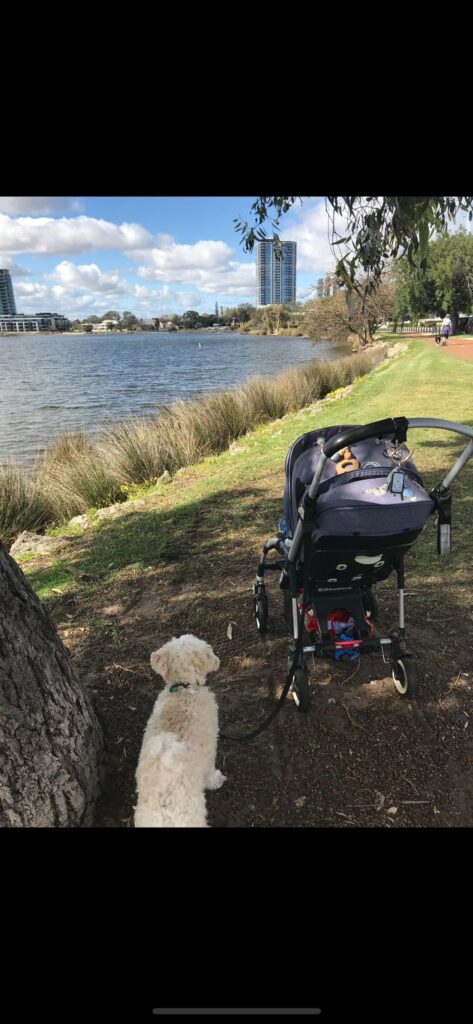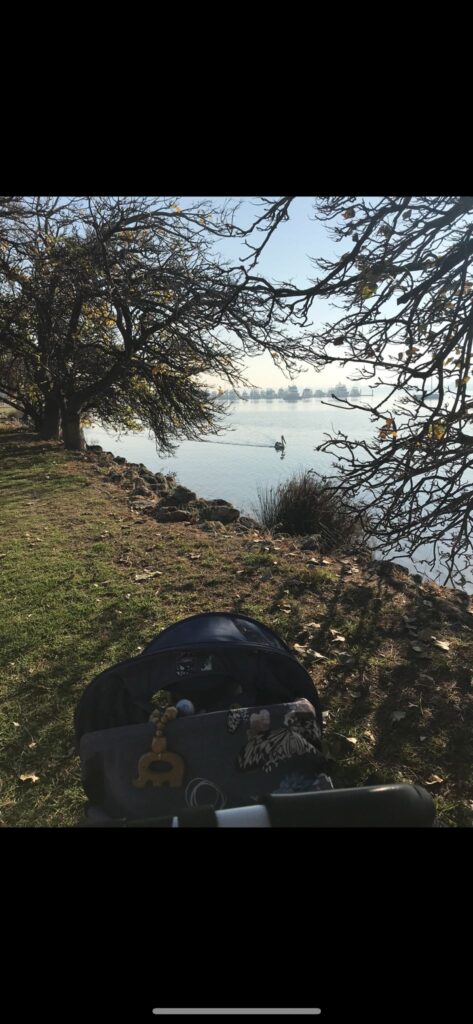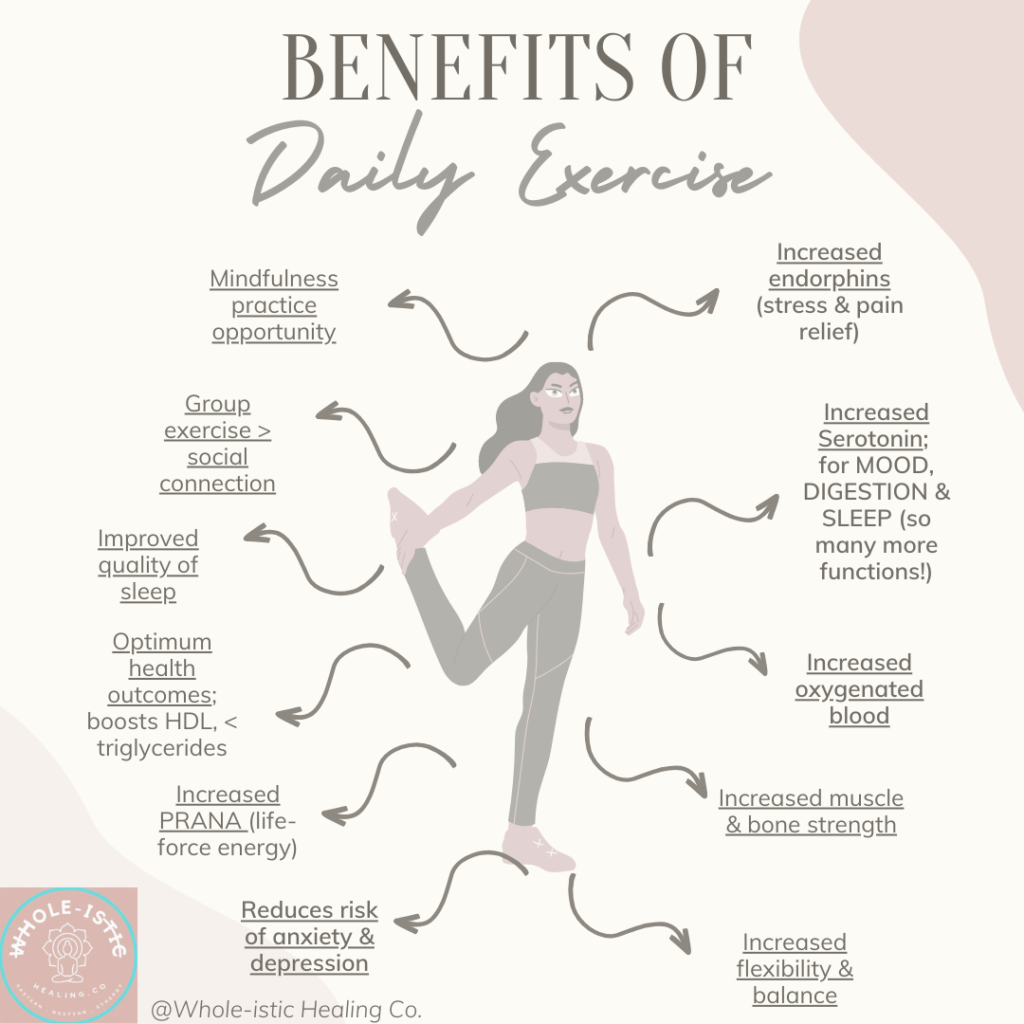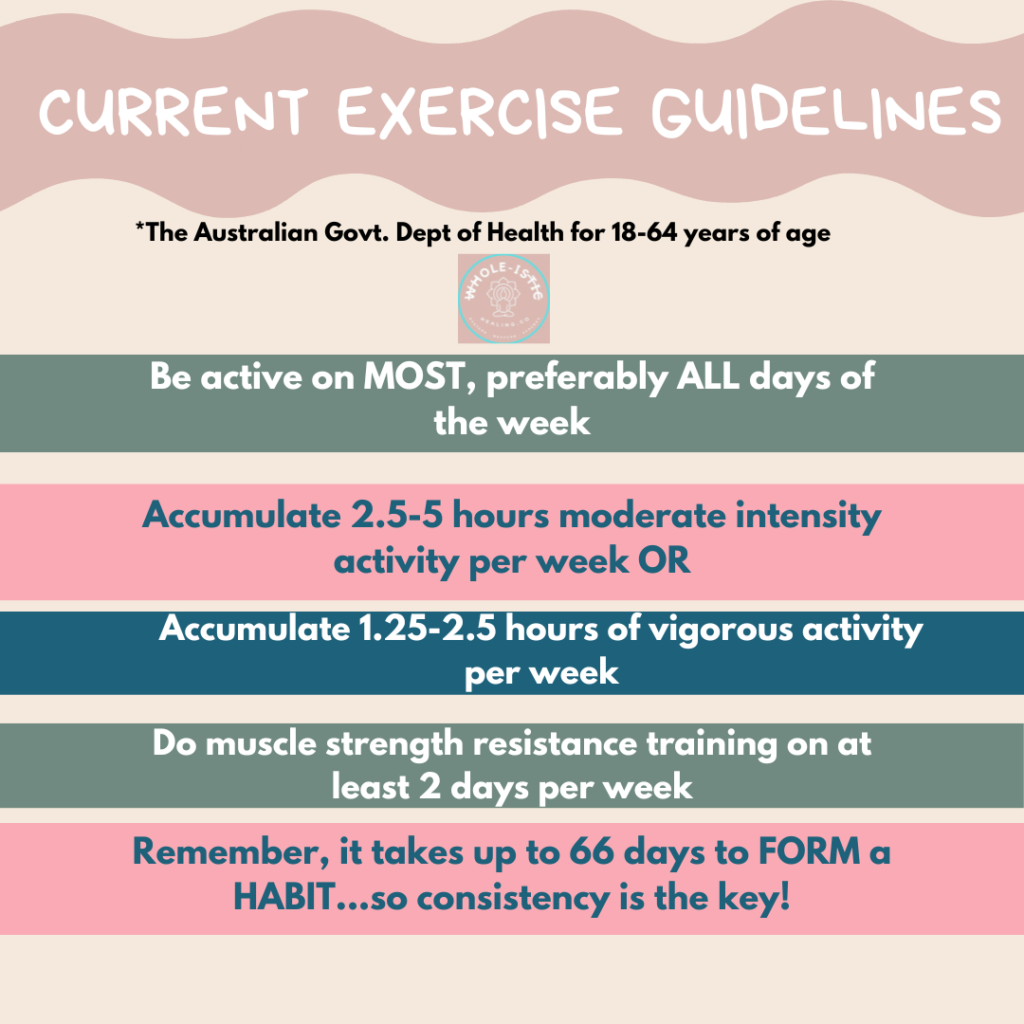Exercise
EXERCISE
Exercise is a pivotal part and a positive strategy to have within your ‘tool-belt’ for benefits to both your physical and mental health.
From the outset, I want to reiterate that when I speak of exercise, it is NOT from the space of;
- encouraging weight loss (though appreciate the impact of markers such as BGL and lipids that reduced weight can impart on the system if there is weight to lose)
- or harsh criticism towards our body, punishment for what we eat, to ‘work off’ calories to enjoy them, not from a space of having to ‘earn’ treats…
The energy of the above feels restrictive and limiting.
Whereas the benefits for me as to what exercise can bring feel;
+ expansive
+ life giving
+ energy building.
I want this strategy to be coming from a PRANA (life-force energy) enhancing space, to utilise the bounty of our body and all the amazing things that it can do, in order to maximise how it operates and feels.
I want it to come from the space of GRATITUDE and UNCONDITIONAL LOVE for the vessel that we have.
Ayurveda’s concept of AMA, or undigested accumulated matter as being toxic to our bodies, pertains to also include unhealthy views and beliefs about our body and selves.
When we eat ‘fast food’ for example, if we tell ourselves with every bite that we ‘shouldn’t’ be eating this and it is ‘bad’ for us; the ‘toxins’ that we are consuming far outstretch the food that we actually are eating.
On the contrary, if we are kind and forgiving as we enjoy each mouthful, we are not flooding our body with emotional AMA, which can flood our body with toxins. This self-talk and perspective towards nutrition, as well as exercise, for me personally, feels like an important aspect to consider.
Looking behind the energy ALWAYS in all that we do, is something I am a firm believer of.
Now, I am going to go through the major questions or aspects of exercise below and I hope you get so much from what I have to share!
WHY is exercise important?
+ Enhanced endorphins that assist in stress and pain relief (we have around 20 different ones in our body!)
+ Enhanced serotonin, which is a chemical required for mood, sleep, digestion, nausea, wound healing, sexual desire and more!
A study by the Harvard T.H Chan School of Public Health, found that running for 15 minutes a day or walking for an hour reduces the risk of major depression by 26%, which is incredible! (helpguide.org)
+ Enhanced oxygenated blood throughout the body; more energy and vitality
+ Enhanced muscle and bone strength (reduced risk of osteoporosis, arthritis)
+ Enhanced flexibility and balance (reduced risk of falls)
+ Optimum health outcomes; boosts HDL the ‘good cholesterol’, lowers triglycerides; overall improved cardiovascular health
+ Improves the quality of sleep (however ideally not completed within 90 minutes of sleep as per sleep hygiene tips)
+ Group exercise can improve socialising to bring fun and connection into your life!
What is the AMOUNT we should exercise?
The Australian Government Department of Health recommendations or guidelines for 18-64 year olds state;
+ Be active on most, preferably all days of the week
+ Accumulate 150-300 minutes (2.5-5 hours) of moderate intensity physical activity or 75-150 minutes (1.25 to 2.5 hours) of vigorous activity each week
+ Do muscle strength resistance training on at least 2 days per week
There are different guidelines for over the 65 age group; the following links you can access the full set of guidelines with different age groups and specific recommendations:
- www.healthresearch.com.au
- https://www.eatmovelive.com.au/wp-content/uploads/2012/09/Physical-Activity-Guidelines-Australia.pdf
What I love about the second link, is the WAY in which they have looked at exercise in these phrases, as it allows it to feel like an honour, as well as grants GRACE to be flexible and make it work for you:
+ ‘Think of movement an opportunity not an inconvenience’
+ ‘be active every day in as many ways as you can’
+ ‘put together at least 30 minutes of mod intensity physical activity on most days; even split them up into 3 x 10 minute intervals’
What are the considerations during PREGNANCY and POSTPARTUM when exercising?
Visit for the most recent health recommendations pertaining to this topic:
+ https://www.healthdirect.gov.au/amp/article/exercise-and-mental-health
+ https://www.healthdirect.gov.au/amp/article/exercise-and-mental-health
As you can imagine, it is difficult for me to give specific advice about YOUR situation; as your health status, fitness levels, pregnancy or postpartum journey looks different! Definitely seek specific advice from your GP, OB (obstetrician) or midwife to understand your situation.
However, generally if you and your baby are healthy then the above ‘’Physical and sedentary behaviour guidelines for adults’’ in the link, is what we should be aiming for.
The benefits of staying active during pregnancy have a plethora of benefits from this above link;
- Preparing for labour and recovery
- Lower risk of gestational diabetes
- Less back and pelvic pain
- Lower risk of incontinence
- Better mental health, increasing a lower risk of postnatal depression
As a side note for this last point, I want to share my experience, in that the first pregnancy I gained a huge amount of weight and did not do much exercise. I assumed this was a big factor for me getting postnatal depression.
The second pregnancy I exercised as normal, did antenatal yoga weekly and gained 1/3 of the amount of weight.
Despite this, on day 5 post-birth, I still got postnatal depression.
I share this not to discourage you, or to ‘un-motivate’ you to exercise! I say this because if you feel that you can exercise your way out of getting it, or cannot understand why you have PNDA or PND because you are so fit, to give you some closure and respite in knowing that it may, like me, just be in your biochemistry and your genetic make-up that predisposes you to it.
I am still so grateful for exercising throughout, as I believe it was what encouraged a successful VBAC (which I had blamed an emergency C-section as a factor causing my PND; ironically the way I birthed my baby was an irrelevant factor too!). I share this for transparency!
Now, with exercise whilst pregnant, moderate exercise is when doing the ‘talk test’, that you should be able to carry on a conversation. Whereas in ‘vigorous intensity exercise’, you would find this difficult.
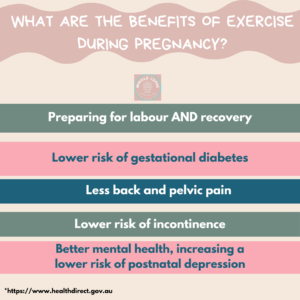
Safety points to consider in pregnancy and postpartum;
+ higher risk of falling; take care with balance and what exactly you are doing
+ anything requiring heavy lifting (lower back issues, pelvic floor and strain in the core region)
+ anything placing significant change in pressure (scuba diving or sky diving) should be considered
+ gives you any pain or discomfort; then stop immediately
It is IMPORTANT to;
+ stay hydrated
+ avoid exercising in hot weather, extreme humidity can make you sweat more and become dehydrated
+ avoid standing still or lying down for long periods
+ care in excess altitude; above 2000m
+ wear supportive shoes, non-restrictive clothing and a supportive bra!
I also believe that seeing a Women’s Health Physiotherapist is SO important to cater for our changing bodies during pregnancy and post-birth (our pelvic floor, supporting our lower back, our core). Our GP, OB, midwife are also excellent resources. Online practitioners such as ‘’Pregnancy with Physio Laura’’ have a wealth of resources to view.
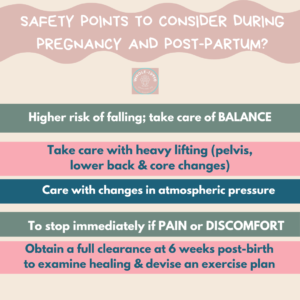
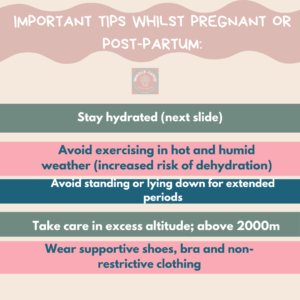
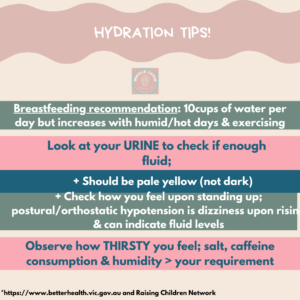
What if I haven’t exercised before?
According to the RACGP, the Royal Australian College of GP’s, the recommendation of exercise is to increase exercise by 5-10 % at a time to reduce the risk of injury or pain flare-ups!
It is interesting, as this year we bought a Nordic exercise bike, and I thought I was Lance Armstrong training for my next marathon! Absolutely loved it and would hop on a track 2-3 times a day! Until…my muscles on the left calf caused my left ankle to be inflamed and felt like I had rolled it! It has been 3 weeks and I still have been seeing a physio!
(My all or nothing trait not serving me, yet again!)
I would say, slow and steady wins the race! Me trying to make up for lost time, actually set me back far more than had I simply completed one training program a day vs being ridiculous! (common sense really!)
Remember it can take 66 days to form a habit, so be consistent, show up each day and do a little more each week.
Exercise from an Ayurvedic perspective; different styles according to the VIKRUTI, as well as the PRAKRUTI
Ayurvedically, this is choosing the right exercise based on what your natural constitution is (PRAKRUTI) and what your imbalance is (VIKRUTI).
For example, someone with a PITTA constitution, which has the FIRE and WATER elements, who has a PITTA vikruti or aggravation, if they do lots of fast intensity running or boxing, that is going to enhance that fire within and run hot, which may enhance the PITTA within.
Whereas, if they chose to do swimming in a cooler pool with lower impact and more controlled motion, it may help to restore the imbalance, whilst also gaining the benefits of exercise.
Partaking in a slow Yin or restorative yoga vs a hot Bikram yoga, and doing yoga Nidra at night; these can help to pacify that aggravated heat inside to bring balance.
Someone with a VATA imbalance, with excess AIR and SPACE; too much movement; known for attributes of being cold/rough/hard…we want more heat; so yoga with slow changes of asana, working our lower body with our BIG muscle groups; will bring about that EARTH and FIRE quality that we want.
Not a start/stop fast paced exercise; but a more grounding practice would be so beneficial. Resistance training would help to bring heat and strength/ that EARTH aspect…
And nothing as beautiful as walking in pure mindfulness and connection connecting with the Earth below.
Swimming in a cold pool for example, wouldn’t be best for a VATA imbalance; as it is bringing too much cold qualities and increasing the aggravation during Winter.
A KAPHA imbalance would need some more AIR and SPACE to counteract the excess EARTH and WATER quality; so a faster style HATHA yoga, or faster pace of walking whilst may be tricky to get them moving, but would enhance their energy and reduce KAPHA.
So in Ayurveda, understanding the essential nature, what is happening within the body, we can tailor a suitable exercise style and pace to help counteract what is imbalanced within the body; as well as dress accordingly depending on the weather and choose nutrients in our ‘kitchen pharmacy’ to bring subtle internal balance.
Concept of Adrenal Fatigue/ burnout and the considerations to think of when thinking of exercise
Now, I will do an episode on BURNOUT; because I feel in this modern world that we live in, we as a collective are burning our candle on all ends. A lot of which comes from;
- information and stimulus overload
- lack of our ‘tribe’; when life has only become busier!
Whilst controversial as to whether it ‘exists’, my understanding of this concept is that when our adrenal system has been ‘on’ for a long time and we are in this ‘fight or flight’, that we end up having too low cortisol, which is our stress home, after it has been firing or ‘up-regulated’ for so long.
Cortisol, by its very nature, allows us to ‘do more’, for example, even running a marathon, whilst we feel we can, it invariably is going to keep our adrenals ‘on’ even more!
I almost see it as a system that once running for so long, it eventually will run out, and lead to low cortisol due to the down regulation of the system.
So you may need more and more cups of coffee to keep working, which is an external stimulant; not giving true endogenous energy but exogenous ‘energy’.
BUT specifically to exercise; in this hustle life, if we’re pumping hours at the gym whilst running a business, household; I would look into the exercise choice so that we can best support our nervous system.
+ Slow yin yoga, a restorative yoga style may be beneficial and nourishing to the system.
+ Gentle walks with mindfulness of feeling what is around you with your 5 senses
Vs doing f45 at the crack of dawn, whilst you rush back to do your next activity, then the next.
Breastfeeding and exercise
Check out this site for information: https://www.breastfeeding.asn.au/resources/exercise-and-breastfeeding
According to the Australian Breastfeeding Association, moderate exercise won’t affect;
-breastmilk supply
-levels of lactic acid
-important immune factors
-major nutrients, energy density, or major minerals
Intense exercise can increase lactic acid, but there is no evidence to suggest that breastmilk with an increased level of lactic acid will harm your baby.
The important thing to note is to maintain adequate hydration; the risk of dehydration when breastfeeding when exercising is important; especially in hot and humid weather.
The recommendation whilst feeding (raising children network) is 10 cups of water a day, but increases with humidity/hot days, as well as exercising.
Tips can include;
+ Look at your urine to determine if you’re getting enough fluids;
-it should be pale yellow; not dark urine which means that you need more water
+ Look at your milk production, is it changing?
+ Look at how you feel; postural/orthostatic hypotension (dizzy upon standing or rising?)
+ This is a helpful link about water intake;
https://www.betterhealth.vic.gov.au/health/healthyliving/water-a-vital-nutrient
Time of day to exercise from an Ayurvedic perspective, as well as with relevance to sleep hygiene strategies
Sleep hygiene practices agree that exercise can improve the quality of your sleep; however, not within 90 minutes of bedtime as it makes you more energised and aroused, more alert and hyperactive.
From an Ayurvedic perspective, exercising between the hours of 2-6 AM or PM, will be the easiest to move your body as it is the VATA time of day.
6-10 AM or PM may be the most difficult, as we are in the KAPHA time of day, as this has the greatest EARTH and WATER element. This is why if you sleep in, it can feel harder to wake up and feel sluggish the rest of the day!
What are examples of LOW impact exercise?
Low impact can be great for your joints, especially if the hormone RELAXIN is circulating in your body during pregnancy! It also can be less harsh on your pelvic floor and a beautiful gentle way to ease into exercise.
+ Cycling, rowing, swimming, yoga; fluid motions
+ Vs running, netball, basketball, tennis (would be high impact: stop/start impact driven sport)
What is RESISTANCE training and WHY is it important?
This is utilising free weights, machines, own body weight, resistance bands to add resistance to your exercise.
It works to improve;
+ muscle strength and tone
+ flexibility and balance
+ increased bone density and strength
+ as you gain muscle, your body burns more kilojoules when at rest.
What are practical ways to incorporate exercise into life with kids?
If we think of 30 minutes as a minimum per day; 7 days a week = 210 minutes (with the goal being accumulated 150-300 minutes per week); we can split it up into 2 x 15 minutes or 3 x 10 minutes.
We can do this by making it incidental;
+ parking further away
+ taking the stairs vs escalator
+ walk vs public transport or driving where you can
+ walking with bub in the pram or a carrier; is so beautiful for both of you!
Also;
+ mat work/ yoga/ Pilates whilst the baby is doing tummy time.
+ gym with a crèche if there is one available
+ group outdoor mum class (check your local neighbourhood, FB groups, child health centre may have more local information and mother’s groups)
+ at home programs; Kayla Itsines, Emily Skye, Sarah B who is also now part of the Sam Wood program, Sharny and Julius have a pregnancy and postpartum program, Physio Laura.
Be gentle on yourself; kind, forgiving, loving, and yet filled with gratitude for your body with all that it CAN do!
Flooding our system with gratitude makes us FEEL good, and when we move our body; that too makes us feel good and the combination is WHY it is so beneficial for our mental health and in the ARMER tool that I speak of.
Whilst I am an advocate for unconditional love; exercise can improve our self-esteem, not to do it to ‘fix’ our body from a space of lack; but it will improve our confidence, our self-esteem, our connection to body.
When we fight through the motivation factor; we will feel empowered and has excellent impact on our mindset and outlook.
How can I enhance MOTIVATION?
+ set out clothes the night before
+ set routine may help; nut it out anyway despite what comes your way!
+ or be flexible if you’ve had a rough night; trudging through if you’re tired may predispose you to injury or a fall…so be kind to yourself and do it later in the day
+ rewards; say at the end of the week, or after reaching a particular goal…it is going to hit that reward centre and give you a DOPAMINE boost that will encourage you to keep reaching and moving forward!
+ mission Statement; a commitment statement to keep you accountable
+ get a PT if your budget allows for it?
+ have an outfit you want to wear as your motivation…it could be for your children, your health, to feel more comfortable and confident in your skin, for yourself…whatever it is; let it be sourced from something LONG lasting and a genuine reason that means something to YOU
+ look into your WHY, the energy behind it and forge forward
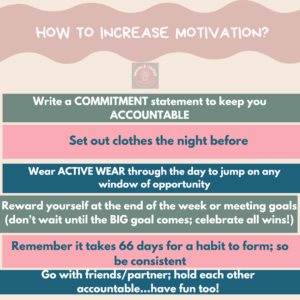
Motivation when in the thick of depression and anxiety?
I hear you! I could barely get dressed, let alone have the initiative to go for a walk.
It then became up to my husband to help me get dressed and literally take me for a walk…much like our dog Ruphus, except that he was always excited to go and I was just filled with dread!
However, even though I didn’t want to go, I did, and it would have brought my system benefit, irrespective of me not wanting to go.
I would call into your tribe here, to best support you with exercise. Do it together! Make it fun, chat, listen to beautiful music, a podcast…if you can go alone if that would also bring you peace of mind, then ask your partner to be with the kids and go!
Practice mindfulness as you walk; to help calm anxiety and act as a grounding and connective time in nature or with your body.
How?
Pay attention to your 5 senses; what can you SEE, FEEL, HEAR, SMELL and TASTE?
Feel the soles of your feet touching the ground with each step.
Listen and feel into your breathing; is it shallow, or fast, slow or deep?
Ask your soul to speak to you and to listen to what is being said.
Other things here to make it easier to take that literal first step include;
+ Set out the outfit the night before
+ Wear active wear throughout the day so that you are READY whenever you can incidentally exercise!
+ Plan the day as best you can with getting someone to help ‘cover’ you whilst you exercise, someone to go with you/to take you, do it with you
+ Give yourself a reward for doing it; celebrate the little wins!
+ Consistency. A little bit each day is so helpful and it ALL adds up!
It can take up to 66 days to establish a new habit; so slow and steady wins the race!
The more you do, the better you will feel, and the more you will be able to do more! Funny how it works!
Your pearl to practice this week, is to carve out 30 minutes each day this week and move your body in a way that you CAN; that feels good for you.
xxx
Namita

